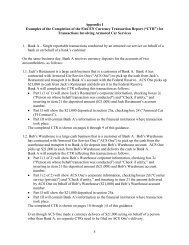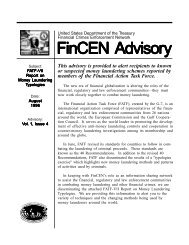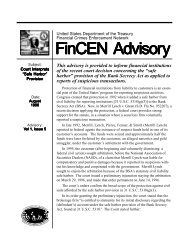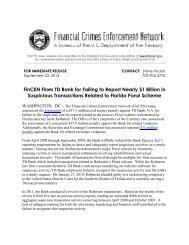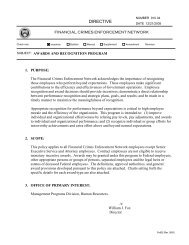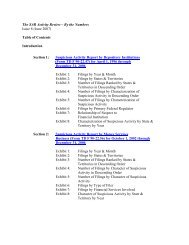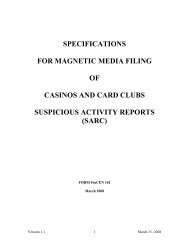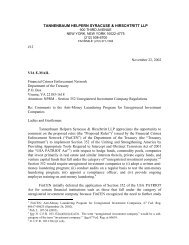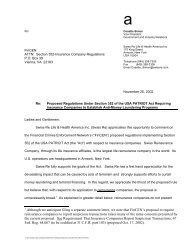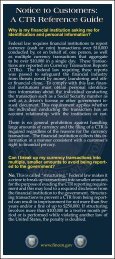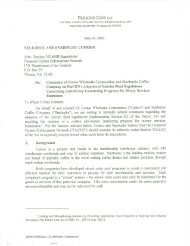FinCEN SAR Activity Review, Trends, Tips & Issues, Issue 10
FinCEN SAR Activity Review, Trends, Tips & Issues, Issue 10
FinCEN SAR Activity Review, Trends, Tips & Issues, Issue 10
You also want an ePaper? Increase the reach of your titles
YUMPU automatically turns print PDFs into web optimized ePapers that Google loves.
transaction or transactions; is derived from illegal activity or intended to hide<br />
or disguise funds or assets derived from illegal activity; is designed to evade<br />
the requirements of the BSA, whether through structuring or other means;<br />
serves no business or apparent lawful purpose and the MSB knows of no<br />
reasonable explanation for the transaction after examining all available facts;<br />
or involves use of the MSB to facilitate criminal activity. 4<br />
Given the growth in number of MSBs, including the ancillary provision of<br />
such services, we are working to ensure that these businesses comply with<br />
federal registration, anti-money laundering program, and recordkeeping and<br />
reporting requirements. To that end, we have begun to study relevant <strong>SAR</strong>s<br />
so that we may understand how, and the extent to which, banks and other<br />
financial institutions identify potentially unregistered MSBs. The first phase<br />
of this study examined depository institution <strong>SAR</strong>s filed between January 1,<br />
2002 and April 30, 2005. The findings from that study, involving 1,214 <strong>SAR</strong>s,<br />
are presented herein.<br />
On April 26, 2005, <strong>FinCEN</strong>, along with the federal banking agencies, issued<br />
interagency interpretive guidance to depository institutions on providing<br />
banking services to MSBs operating in the United States 5 (Interagency<br />
Guidance). In that guidance, we specifically directed depository institutions<br />
to file <strong>SAR</strong>s on businesses that are unregistered or unlicensed MSBs. We<br />
also stated that the guidance was not “a directive to banking organizations<br />
to conduct immediately a review of existing accounts for known MSBs for the<br />
sole purpose of determining licensing or registration status.” <strong>FinCEN</strong> and<br />
the federal banking agencies’ expectations have not changed in this regard.<br />
The Interagency Guidance has been incorporated into the Federal Financial<br />
Institutions Examination Council’s (FFIEC’s) 2005 BSA/Anti-Money<br />
Laundering Examination Manual. 6<br />
Preliminary research reveals that between May 1, 2005 and February<br />
28, 2006, depository institutions filed an additional 2,934 <strong>SAR</strong>s related<br />
to suspected unregistered MSB activities. The filing volume during this<br />
ten-month period reflects a 142 percent increase over the more than three-<br />
4 See, generally 31 C.F.R. § <strong>10</strong>3.20. Special note concerning issuers of money orders and traveler’s<br />
checks: issuers are only required to report transactions or patterns of transactions that are suspicious<br />
and involve or aggregate funds or other assets of at least $5,000 if identification of those transactions<br />
is derived from a review of clearance records or other similar records in connection with items sold or<br />
processed. 31 C.F.R. § <strong>10</strong>3.20(a)(3).<br />
5 See “Interagency Interpretive Guidance on Providing Banking Services to Money Services Businesses<br />
Operating in the United States,” (April 26, 2005) available at<br />
http://www.fincen.gov/guidance04262005.pdf.<br />
6 An electronic version of the FFIEC BSA/AML Examination Manual may be found at http://www.ffiec.<br />
gov/bsa_aml_infobase/pages_manual/manual_online.htm.



